The first time someone pointed out that I had problems with my handgun grip was at Tom Givens’ Rangemaster Instructor Development course in 2013. It was the most challenging class I’d attended to date, and it was the first time I was pressured to shoot faster than I was accustomed to.
Tom marched past me on a drill and said, “After every shot you readjust your grip.”
I wasn’t aware that I was doing it up to that point, but now that he mentioned it, it was glaringly obvious—and frustrating. Why couldn’t I seem to keep a consistent grip? Tom’s recommendation to me was that my double-stack Glock was simply too big for my hands, and once I moved to a smaller gun, I would likely see improvement in my grip. Unwilling to give up my double-stack capacity, I saw little improvement in my recoil control at high rates of speed. My left hand would break from the gun, and my splits (the time between shots) would increase.
I soon realized that asking the questions, “What’s wrong with my grip?” and “How do I fix it?” would lead me down a rabbit hole and through a Wonderland of theories and advice from competition shooters, strength coaches, engineers, and a half dozen more instructors. I went looking for a cure for my own grip issues and came out the other side with a better understanding of gripping mechanics, and a better instructor.
Reasons For Handgun Grip Problems
1. Lack of Strength
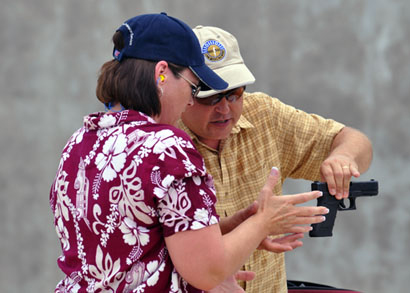
At the top of my list of people to talk to when I started researching grip issues was Karl Rehn. Rehn is a IPSC Grand Master who started competitive shooting around the time I was born. In addition to taking almost every shooting class available from every major gun school in the country, he’s also an instructor who is well-versed in the history of shooting and technique.
Rehn’s master’s degree in electrical engineering encourages him to look at things analytically. I contacted him after learning he’d done an extensive in-house study on grip strength and performance in relation to gripping techniques. Rehn began his grip study after seeing frustrated students (particularly women) who would experience their grip breaking.
“I got tired of dealing with people who kept pushing their thumb down,” says Rehn. “In my school, they call them thumb pushers. What happens is, when you go to pull the trigger your thumb moves in tandem with your trigger finger, and I kept trying to figure out why these people are having this problem, and why, when I tell them to stop doing it, they can’t.”
Karl began his research in grip with the two different types of grips humans are capable of: clamping, which uses the strength of the fingers without the thumb, and a crush grip, which adds the strength of the thumb in the form of a fist. He went on to explain that the modern thumbs forward grip commonly used in shooting schools today is using a clamping grip which, though optimal in performance, requires a certain amount of strength that some people just don’t have.
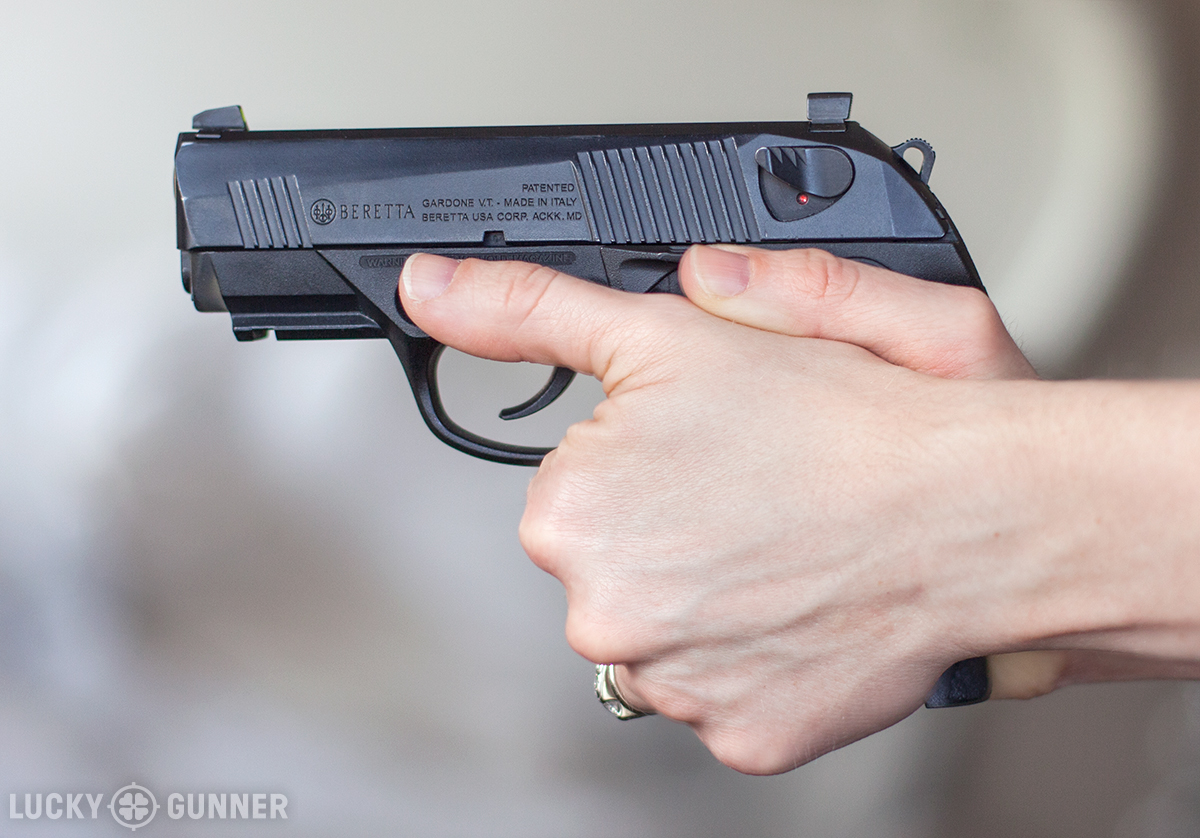
Rehn conducted his study by passing around grippers that required 60, 80 or 100 pounds of grip strength to close. He found that those with over 100 pounds of grip strength saw the maximum benefit of a thumbs forward grip, but those who had less than 60 pounds of grip strength were the ones who had the most problems utilizing it, or even operating their pistols in general.
“People that don’t have 60 pounds of grip strength generally can’t rack the slide on a 9mm pistol. They can’t grip the slide hard enough,” says Rehn. “That’s why, when they can’t operate this gun most of the time [it’s due to] lack of grip strength—grip and forearm strength… The thumbs forward grip works optimally if you are above the threshold strength, particularly in the little three fingers of your shooting hand. If you aren’t above the threshold strength, then having someone tell you to grip the gun that way and to just keep trying doesn’t work.”
His proposed solution was either to gain strength or switch to a crush grip that was advocated by Massad Ayoob in the 80’s and is still taught in some schools today.
“Folding both thumbs down and basically making two fists, that technique works for everybody regardless of grip strength. It’s not optimal, but it works for everybody,” Rehn says. “You don’t get the same wrist rotation. You don’t get as much counter-torque on the pistol, but people can actually grip the pistol.”
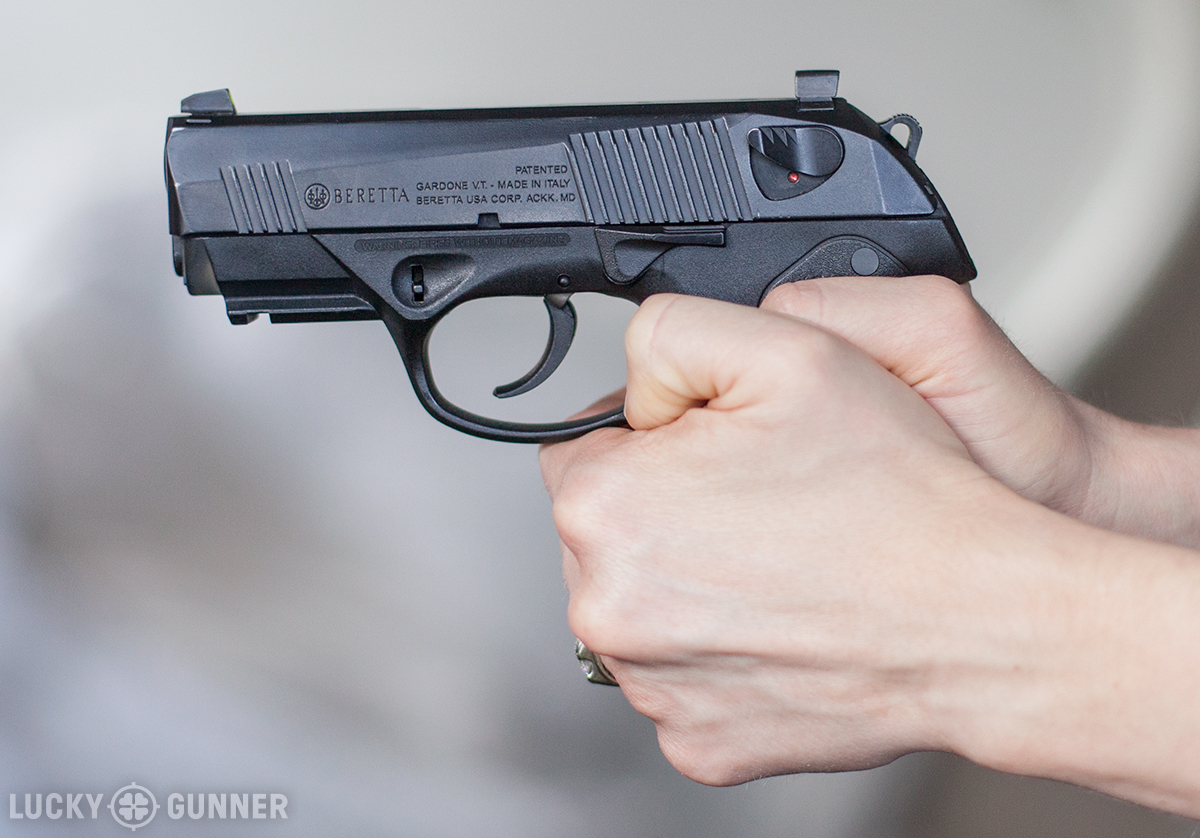
2. Injury
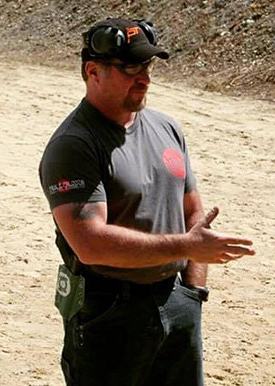
What if you are trying to shoot, practice, and improve, but you have an injury to your hand, wrist, arm, or back that is affecting your ability? Maybe its one you will heal from, but maybe not. How can you learn to grip a handgun that works around your physical issues? Paul Sharp might have some advice. He is certainly no stranger to an effective grip despite multiple injuries.
“I was having a hard time even closing my hands to make a fist…and I had an elbow injury, too… so that’s what got me pursuing that whole approach to recoil management.”
Sharp is a black belt in Brazilian Ju Jitsu, an eighteen-year veteran police officer, firearms instructor, weight-lifter, and has a particular affinity for fighting, having spent his childhood both wrestling and boxing. One of his particular passions, however, is firearms grip issues and recoil management.
“At the time, I started training the D.R. Middlebrooks FIST-fire method, and I had a bunch of hand injuries from mixed martial arts and boxing, so having a really strong grip was something that just wasn’t going to happen for me at that time,” said Sharp. “I was having a hard time even closing my hands to make a fist…and I had an elbow injury, too… so that’s what got me pursuing that whole approach to recoil management.”
In addition to the hand injuries, Sharp also had tendinitis and a partially torn bicep. His shooting slowed, and his hands came apart from the gun when he fired.
“It was really hard for me to make that torquing motion and squeeze at the same time,” says Sharp. “It was just really painful. I had to figure out a way to get around that and get around crushing the gun, so to speak.”
When asked what method he found to overcome these issues, he explained, “I started focusing more on pulling through the pinky of the left hand—the support hand, for me, because I’m a right-handed shooter. So, I started focusing more on putting a lot of pressure through the pinky, against the bottom of the front strap and that helped tame the gun—the lift of the pistol in recoil. That helped settle the pistol down and keep it flat. And I started focusing on driving my right hand into that pinky—almost like a Weaver-esque isometric tension-type thing happening there where I’m pushing with the right hand as hard as I can and pulling back with the left as hard as I can. It’s coming from the shoulders because I had that messed up bicep, and I couldn’t pull with my arm bent so I would use my shoulders to push and pull. And that really tamed the pistol, really made it settle down and sit flat for me, and I was able to get my follow up shots.”
Paul figured out how to work around his injuries to maintain a solid grip on his gun. In the process, he found that his ideas on grip often also helped those without a hand injury control their firearms more effectively.
3. Poor Instruction–One Size Does Not Fit All
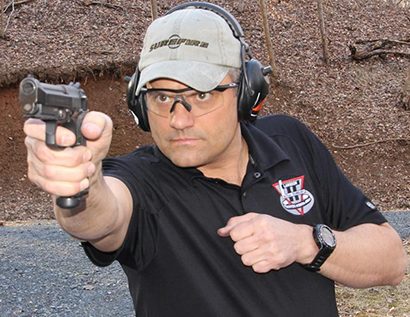
Ernest Langdon is a full-time firearms instructor and industry consultant who has been teaching firearms and competing since the late eighties. He’s a graduate of 35 different formal shooting schools and holds numerous instructor certifications from the military, the FBI, the NRA, and has trained over 4,000 students in advanced shooting skills.
After taking a class with him and being thoroughly impressed with how well he evaluated my own shooting errors, I was compelled to collect his thoughts on grip for others. He was quick to point out the importance of physical strength.
“The first thing that I would say is that improving your grip strength is critical,” says Langdon. “If you want to shoot a handgun well you have to know the stronger your grip, the better you’re going to be able to shoot it. And being able to control recoil and put rapid shots on target relates to strength, and there’s no way around it. No technique in the world is going make up for lack of horse power.”
“For most people, a significant amount more effort with their support hand when they’re shooting a two-hand grip will help in controlling the gun.”
As to the actual technique, Langdon had this to say, “High on the gun as you possibly can. As much surface contact area and skin on the gun as you can. As few gaps as possible. Learning to lock the wrists—both strong and support hand—in a way that helps control the muzzle flip of the gun. For most people, a significant amount more effort with their support hand when they’re shooting a two-hand grip will help in controlling the gun.”
“For most people with smaller hands who do not have a lot of grip strength, I also advocate a push/pull between their strong hand and their support hand to try to help mitigate recoil and mitigate their support hand from slipping off the gun.”
Ultimately, however, Langdon explained that grip is a personal thing affected by many factors such as the gun itself, the shooter, their strength, size of hands, length of fingers, injuries, etc. Langdon cautions anyone against either teaching or accepting one universal technique for all shooters.
“It becomes difficult because what someone has figured out works for them, they want everyone else to do it the exact same way, and that doesn’t necessarily work for everybody because one size does not fit all,” says Langdon.
4. Gripping With Only Your Hands
As a small-handed shooter, I wanted to get the input from someone else who was small but also an accomplished shooter. I didn’t have to go very far to find my friend Annette Evans. She’s a petite lawyer with small, thin hands who is also a competitive shooter with Team SIG. She started her competitive shooting career in 2010 and is a IDPA Expert in ESP and USPSA Production B Class shooter with ambitions of going all the way to Grand Master. While she’s now a professional shooter and instructor, she’s had her share of struggles along the way.
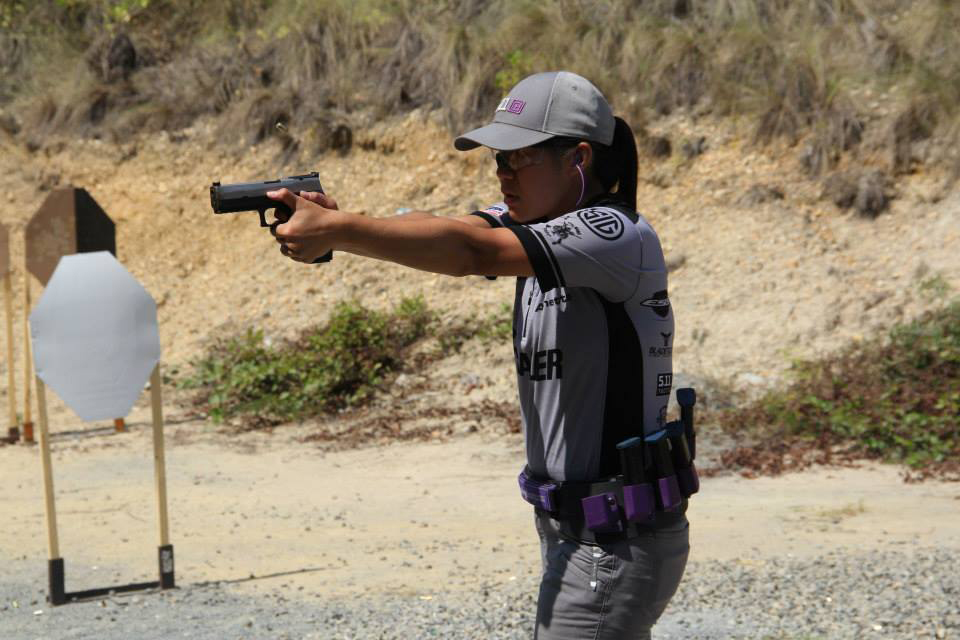
“With the size of my hands, it was very difficult for me to find guns that were comfortable in my hands and that I could manipulate and shoot well,” says Evans.
Finding a suitably fitting gun was not her only problem. Her performance also suffered.
“When you don’t have average grip strength, when you think you’re gripping really hard, maybe [you’re] not.”
“Most of the problem was that the sights weren’t tracking predictably for me, and they certainly weren’t tracking up and down.” She could run the trigger fast but couldn’t get accurate follow up shots.
Her turning point was in a class with five time US IPSC National Production champion and instructor, Ben Stoeger.
“He demonstrated, hands on, exactly how hard I should be gripping with the left hand,” says Evans, “That really gave me a better tactile feel for what people meant by gripping really hard. When you don’t have average grip strength, when you think you’re gripping really hard, maybe [you’re] not.”
“That was the first, ah ha moment of, ‘Oh, when you meant hard, you meant really hard.’”
Evans explains that her grip and process for managing recoil relies on far more muscle activation than just her hands.
“I start my grip up in my shoulders now and in my core,” she explains. “I’m trying to make the back tips of my shoulder blades touch each other so I’m really bringing my shoulders back and I’m squeezing my armpits together. If you do that and stick your hands in front of you you can see how the bottoms of your hands start touching and it becomes a vice. That’s where a lot of my grip strength comes from right now.”
Symptoms and Diagnosis of Grip Problems
Many people can tell if there’s something wrong with their grip. Sometimes, however, it takes someone else pointing out their struggles to them.
Symptoms of a poor grip usually include:
- Hands breaking away from on another
- Inconsistent tracking of the sights
- Lack of consistent hits on small targets at 3-5 yards
Some people may immediately be able to identify the source of their grip issues, particularly if those issues are injury or strength related. If, however, the shooter is healthy and strong, identifying the particular issue can easily cause frustration.
“They just try to go faster for the sake of going faster, and they lose sight of the actual technique of what they are trying to accomplish.”
Diagnostic tools like slow motion video can help shooters see where they are having difficulty. Some smart phone cameras can even slow things down enough for you to see what is wrong with your grip. At some point, however, you may need to call in a professional. Annette Evans recommends finding an instructor with experience and skills in the fundamentals.
“You need somebody else who has that breadth of experience to observe, and it needs to be somebody who approaches shooting the same way that you do,” she says, emphasizing the need to find an instructor who understands or has already accomplished your shooting goals.
Ernest Langdon has a similar take on finding help and recommends people go back to the basics of making sure they are doing each step correctly.
“I often find that people start to get focused on the outcome and not necessarily the process, so they just want to go faster,” says Langdon. “They just try to go faster for the sake of going faster, and they lose sight of the actual technique of what they are trying to accomplish. And whether that’s trigger control or whether that’s actual proper technique… the reality is if they don’t slow down, force themselves to do things absolutely correctly, and break down the processes so that they learn how to do each component correctly, then it’s very difficult for them to progress.”
There Are Guidelines, But They Are Just Guidelines
All four of the instructors I talked to believed the modern method of gripping a pistol was the optimal way to manage recoil; getting a high grip with as much contact as possible between the gun and both hands and driving the thumbs toward the target was considered the best technique if the shooter has the requisite strength.
As to how hard to grip your pistol, all of the instructors gave the same advice: Grip it as hard as you can, with both hands, without inhibiting your ability to manipulate the trigger consistently.
“A lot of the tactical guys, they only teach super motivated, fit, really switched-on people. They don’t see the people that I see. I get the 60 year-old women with tiny fingers and small hands and arthritis and no grip strength.”
In the end, however, each shooter is unique and the combination of their gun, strength, physique, and goals will make for their own optimal way of using the gun, and each instructor had his or her own closing words to say on the matter.
Karl Rehn points out the specific needs of his students, “A lot of the tactical guys, they only teach super motivated, fit, really switched-on people. They don’t see the people that I see. I get the 60 year-old women with tiny fingers and small hands and arthritis and no grip strength.” He filters his students by strength and teaches them the technique that works for them, “I’m not going to waste your time teaching you this other technique because it requires a threshold of physical capability that you don’t have, and it’s not going to work for you.”
Annette Evans cautioned shooters not to get so caught up in copying that they fail to find what works for them. “Do people fail to figure out their own grip because they are spending too much time emulating what they think is the right thing?” she asks. “I think that’s true for all things shooting… and the rest of life. I think that when we copy without understanding why, we don’t have the tools to evaluate whether or not it actually works for us because we’re just kind of doing what our idol says.”
Paul Sharp said, “I learned to muscle the gun and make it do what I wanted it to do, and then when I got hurt, I didn’t have good enough technique to get me through being hurt, so I had to kind of start over… I would concentrate on technique because [shooters] can always apply strength to technique.”
Ernest Langdon encouraged shooters never to give up, “We have this tendency to always try to compare ourselves to the people that are the best in the world. Everybody can’t be the best in the world… At the end of the day you have to say, ‘Here’s what I can do. I’m going to go to the range. I’m going to practice. I’m going to be as good as I can be and strive to get better. And nothing else…’ You’ve got what you’ve got. Try to improve it. Try to get better, and, I would argue that, over time that will happen.”


Great tips!
One point that came up in follow on discussions with Melody is worth mentioning here. If you have 80-100 lbs of grip strength, but you are only using 60% of it when you grip the gun, you aren’t getting as much pressure on the gun as someone with 60 lbs of grip strength who uses 90% of it when they shoot. Someone that only has 60 lbs of grip strength who does a lot of dry and live fire work gripping the gun hard will build grip strength from that effort even if no other cross training is done.
Thanks for the follow-up, Karl!
Thank you, thank you, thank you. I don’t usually find articles addressing my most serious problem as a shooter. I am a woman, and I will soon reach my 80th birthday. I own mostly compacts and sub compact guns. My hands are weak, and I do have back pain. This article has shown me a way to overcome these problems and become a better shooter. I have also learned that I can shoot a 1911 full size. The grip is slim enough that I can easily reach the trigger. I have been doing dry fire practice and am anxious to get to the range to try it out. I will reread and practice the great tips in this article until I feel I’ve “imprinted” this in my brain. (that also takes longer these days.)
I read and keep all the articles on Lucky Gunner Lounge and want to thank you for all the great tips.
Glad you found it helpful, Ann! With that kind of dedication to training, I have no doubt you’re a formidable shot, or at least well on your way. There’s a lot some of our younger readers can learn from that attitude…
time for a shotgun sister.
Hard to conceal carry a shotgun.
Kudos to you Ann, I love the can do attitude you exude! I have 1911`s and Sig Sauer double stack magazine pistols and I do have to grip differently on the two, I have large hands and the 1911 is thin in comparison. I have now gotten to the point over time that soon as I pick up the pistol, whichever one I am shooting, the grip automatically goes to the right grip for the pistol.
Good article and nice to have some reinforcement on the grip issues. There are still so many well meaning gentlemen who assume their partners can and will be comfortable with the gun they have and push them into the same thing with frustrating results. I work with a lot of female students in this situation and once we get them on the right track they become much more comfortable and progress their skill sets faster. They also tend to shoot more. One size does not fit all.
Good article, however, I dont see where you show or explain of any techniques to try to fix or improve youur grip strength? I have about 70lbs grip strength (recoverying from hand an wrist injury), I can rack my Glock 19 and my FN57 fine, but the 1911 a bit more difficulty…I do the thumbs forward as that is how I have always been trained…but what can I do to increase the grip strength to get to the 90+ again?
I just recently dropped a 460 Rowland conversion in one of my 1911`s, That changed the recoil spring from 16# to 24# and it takes a great deal more actual grip on the slide to rack it now than before. The great part is with the compensator I can shoot it one handed and stay right on target.
This article is right on…any help we old guys can learn to overcome years of ‘physical abuse’ is appreciated. Your ballistic gel testing is also a great tool. I recommend to all my shootin’ compatriots. Thanks,cpc (a customer for life)
Would like to see more about shooting 1 handed. I’m 60 and must walk with a cane, don’t want to drop the cane to shoot 2 handed and then be stuck where I am. And my bad back (the reason I need the cane to start with) won’t let me reach down to pick it up if I were to drop it. I carry a S&W shield in 40, The grips are almost to small for me but its an easy gun to carry concealed ( I use the 7 round mags., the 6 round mag has no place for my little finger). When I do get to the range and practice 1 handed I have noticed its hard to get fast follow up shots.
I hate to tell people “you have the wrong gun”, but the Shield in 40S&W is a very hard gun to control as it is. With one hand, it’s going to be nearly impossible to get quick successive hits, even with perfect technique. If you are able to, I would suggest switching to the 9mm Shield. The 9mm M&P Compact would be even easier to shoot. Regarding tips on shooting one handed, that’s a great idea for a future article or video. We’ll definitely add that to the list.
Another variation on the theme……..I recently found my Kahr PM9 was too small a gun for my hands. I couldn’t figure out why both my friend and myself were totally inconsistent when shooting it. Then a range officer pointed out it wasn’t properly supported by our hands. Putting a long magazine with a sleeve and an extension markedly improved our accuracy. I bought it to conceal carry, but I’ll need to sacrifice some of that small size to have the accuracy I need in a defensive situation. Going forward I’ll need to consider the possibility of a gun not having enough grip length.
That’s a great point. I’ve never felt comfortable with any gun where my pinky finger is off dangling in the breeze. The gun should fit you, not the other way around. If you’re working to overcome the shortcomings of the gun, then something is definitely wrong with that picture. Thanks for helping me put coherent words to that aspect. I teach concealed carry, and this is a good thing to keep an eye out for with my students.
I have the same situation. I have the Kahr CM9 which I bough as a CCC that I could carry IWB or in a pocket holster, if necessary. My profession, office, and work wardrobe requires very discreet carry. I can be accurate with it but not at any sort of rapid rate of fire. The grip feels to small and my trigger finger protrudes too far through the trigger guard to the point that my support hand can impede it’s travel. Even the slightly thicker grip of my Bersa Thunder 380 feels more comfortable.
I will keep the Kahr CM9 as it is the most concealable 9mm but i may try a grip sleeve and work on my hand and forearm strength.
I have a Sig, p290 and I found the extended Mag with the little finger nook really helped my grip. My little finger would just hang off because of the shortness of the grip…with my husband’s hands…ring finger and little finger would be in space. Love the little Sig tho, and I keep the extended on, at all times now. The shorter I use for practice, but don’t really care for it, so I don’t know why I bother with it, really, LOL
This was a GREAT article!
Seriously. Really good job.
I’m more of a revolver guy, although pistols do reside in my safe. Every handgun I own may be similar, but in reality, they are mostly dis-similar. I only have one pair of hands, so I have to adapt to several different grips. A S/A revolver requires a different hold than a D/A snubby, a pocket pistol is held differently than an AR pistol.
I hold firm enough to keep control with my dominate hand, then use my other only as support to keep my sight pic from shaking as much, probably most like Ayoob’s double-fisted approach, but without the death grip.